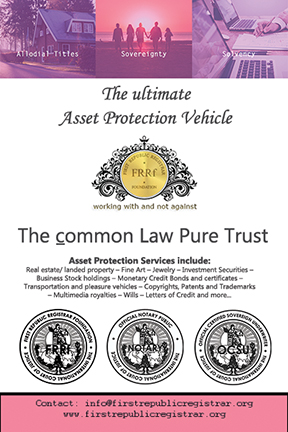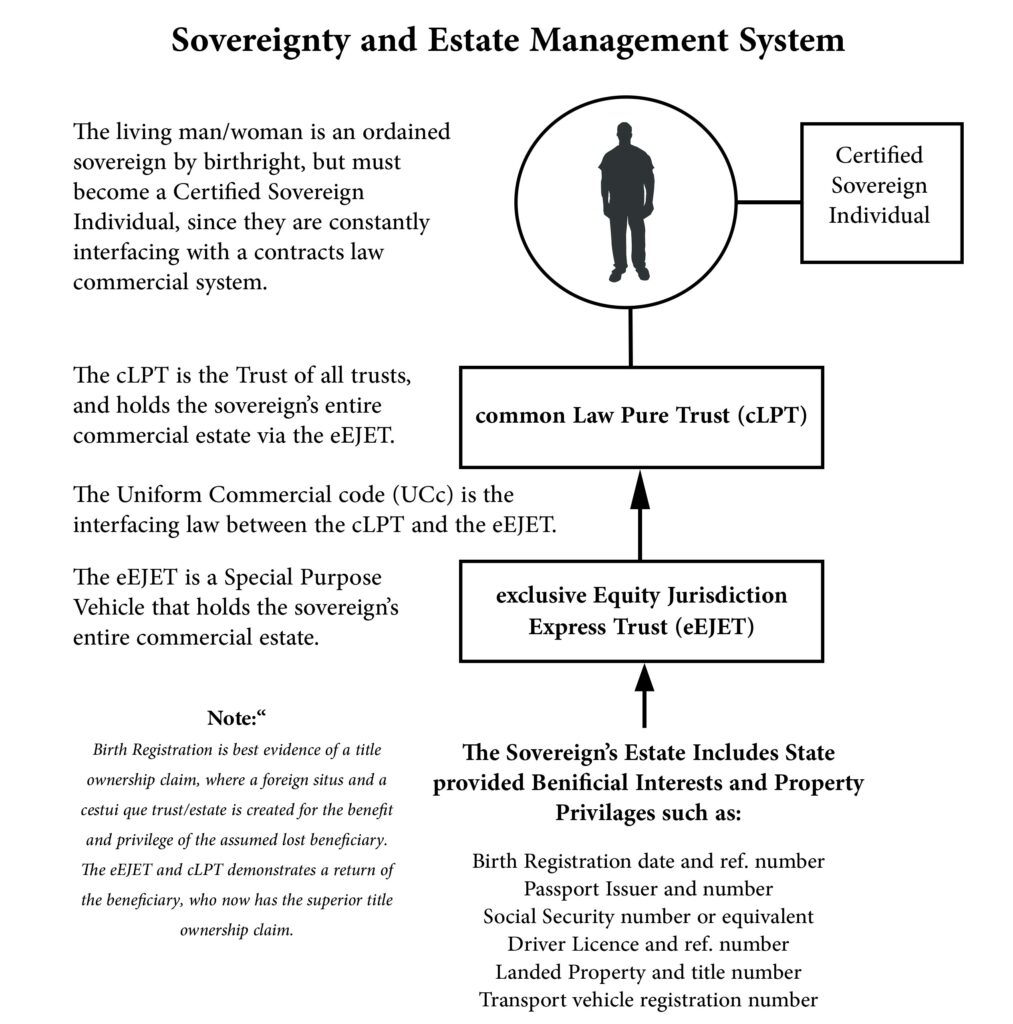
The cLPT is the perfect vehicle for estate management and asset protection.

Introduction to the cLPT
The importance of a common Law Pure Trust, is that governments were originally created by such a vehicle. However after many generations, we as the “common” people are increasingly not made aware of this fact.
Historical documented records prove that some created government(s) “got out-of-hand”, and so there became a requirement for protection from what was often termed as legalized tyranny.
Therefore, the richest families (Polity) i.e, von Bauer-Rothschild, Rothschild, Rockefeller, Brown-Harriman, von Warburg (twelve in all – et al), created their own Pure Trust provisions (“PTp”).
The said provisions of the cLPT are available to you, via our Sovereignty Certification and Estate Management package.

The cLPT protects one’s estate, land and assets from any government intervention. By positioning your estate, land and assets properly, you manage and control them, but never own them. The language of the cLPT is critical for proper control. In simple terms, if one owns land and assets, they owe taxes, duties, and allegiance to the managers/controllers. However, one can hold all assets in a cLPT and take the position of manager/controller and therefore become both ‘licence’ and ‘tax’ exempt. It is that simple; the sole way of re-positioning oneself is through a cLPT. For further information, please contact your trust representative at FRRf.
For those of us who are unaware, the world of commonwealth and corporate governments was declared bankrupt, since the 1930 Geneva Convention. As such, currently, governments, businesses, and non-enacted sovereigns, have no authority to act against living men and women.
It should also be noted that the plaintiff of any claim (in the courts or otherwise), does not reveal that they are acting on behalf of one of the Polity (12 richest families and their top twelve banks). This is a violation of the Uniform Commercial code (UCc) §1-308, which requires full disclosure and remains the precedent. If such disclosure is not revealed, then it is challengeable under the UCc bankruptcy laws of §1-308, “A party with explicit reservation of privileges, performs, promises, and/or assents unto performance offered and/or demanded by the other party does not prejudice the privileges reserved” (it is very important to memorize this citation). In other words, the defendant is putting the plaintiff on notice that the former is aware of the law and counterclaiming or crossclaiming (countersuing or cross-suing) and/or making a redress of grievance under two counts of violating the UCc. Namely, that the plaintiff has (1) no authority to operate or act whilst operating in bankruptcy and (2) has failed to reveal the identity of the original or primary plaintiff.
Historical Background
The common Law Pure Trust originated just after the middle ages in the 12th century with King Henry II Plantagenet. Prior to this, the Catholic Church had control of most land and assets. After Henry finagled some away, he established the cLPT with his new partner Lord Bauer, the progenitor of the present-day Bauer-Rothschild family, the richest of the twelve (+1) polity or rich bank trading families. The cLPT provisions (the written rules [principia] of the trust), have had one hundred and four (104) revisions. The last three have been revised by a former Bauer-Rothschild attorney, Baron von Brauchitsch Bauer-Rothschild. The Rev. CIV is the one available with FRRf.
King Henry and Lord Bauer made the first fidelity ceremony circa the 12th Century, as explained in Art. I of Rev. CIV provisions, providing the cLPT creation and execution. Post this period, the concept of the cLPT has remained unchanged.
Pure Trust certificate (PTc)
The fidelity ceremony has created a misnomer that the cLPT is somehow tied to marriage between a man and woman, when in fact, the cLPT is about contract marriage, but not a marriage contract. A contract marriage means that two people come together in tryst, meaning the the meeting of two-minds, with no romantic connotation, and exchange an agreement of vows in the form of a Pure Trust certificate (PTc)(trust, derived from the word “tryst”). The PTc simply verifies or proves that the fidelity ceremony occurred. Once this extremely important tryst takes place, the trust is executed after the two parties sign the trust certificate and the addenda acknowledgements. Originally, only the PTc was signed, but later the polity deemed more explanation and signing was necessary for execution, carrying-out, initiating, effecting, starting, etc., the trust.
This introduction also gives a cursory instruction in execution of the trust. The “cursory” factor means that when one receives their trust, they only need to sign certain documents in order for it to be executed, as some other signatures will already have been done, which alleviates time constraints of the managing Director (mD). However, one should know as much as possible about their own trust, whilst the mD is appreciative of the fact that the present revisionist-author has taken many years to become proficient in this work.
Special Deed of Trust
This Instrument is set-out for the purpose of setting out the intent, subject matter and parties, in reference to the privately held cLPT. Within the Special Deed of Trust, the Exchangor/Grantor’s complete commercial-estate is expressed as a holding of the cLPT.
Upon the Exchangor/Grantor becoming self-realized, primarily as an ordained sovereign individual, he/she can now express a Trust Declaration as a special purpose vehicle (SPV), for protecting their estate and their birthright, sovereignty and nobility.
Parties to the cLPT
Creator: The party who creates the Pure Trust Instruments;
Pure Trust certificate (PTc)
Pure Trust provisions (PTp)
Declaration of a common Law Pure Trust Contract (DcLPTC)
Addenda Contracts
Exchangor/Grantor (E/G): The party who grants assets to the Pure Trust in exchange for the Pure Trust Provisions and Instruments;
First Trustee (and subsequent Trustees): Holds the List of Assets and all Trust instruments of the Trust corpus (res);
managing Directors (mD): appointed/elected by the Board of Trustees (BoT) to carry out duties under the provisions of the Trust.
Contact us here for more information.
